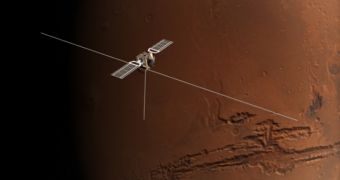The MARSIS instrument, or the Mars Advanced Radar for Subsurface and Ionosphere Sounding instrument, on board Europe's Mars Express probe was originally designed to look for water beneath the Red Planet's surface but could also easily penetrate the ice sheet covering Jupiter's moon Europa or the surface of Saturn's Titan as well as that of Earth. "I was having discussions with scientists from MARSIS, and I saw that what they had done could be applicable to Earth", said ESA scientists, Florence Heliere.
MARSIS is basically a radar antenna spanning 40 meters from the main body of the Mars Express spacecraft. MARSIS' main antenna sends radar signals to the surface of Mars, which are reflected back and collected only to create a map of the layers beneath the top layer of the planet. Another smaller antenna could collect scattered signals coming from areas other than those located directly bellow the spacecraft, albeit it was later decided that in fact another antenna is not even necessary.
A similar approach was used when scientists thought of developing the Advanced Concept for Radar Sounder, having as purpose the study of Earth's Antarctic ice sheets. "Antarctica is an area where the ice is cold and dry, so you can penetrate up to 3-4 kilometers within the ice", reckons Heliere. The mission could eventually create a detailed map of the ice thickness and a three dimensional picture of the structure of the ice sheets, which would help scientists evaluate how the ice sheet evolves over time through ice melting and refreezing.
The problem is that ACRAS would have to work in a bandwidth between 1.3 and 5 MHz, which is against international regulations that only allow Earth observations in a bandwidth around 435 MHz. Alternatively, observations within Earth's atmosphere are usually conducted by using radar frequencies between 60 to 150 MHz. Although the MARSIS instrument made use of a secondary antenna to collect clutter signals, ACRAS will again follow the modifications made to the Mars Express and use a single antenna to send and receive multiple radar signals.
Another possibility would be to filter out the clutter signals coming from the direction of travel by making use of the Doppler effect, which will determine an apparent compression of the signals coming from the direction of travel. The last clutter filtering technique considered for the ACRAS involves distorting the radar signals through the Earth's ionosphere, although the autofocus technique developed by the German Space Agency still requires further testing before coming into use.
ACRAS could launch as early as 2015 depending on whether or not it receives approval. The moons Europa and Titan may also receive the visit of similar spacecrafts in the near future. "This is applicable to Titan, Europa or Mars again to improve the capabilities of radar sounding. I originally worked on Earth as the main subject, so this has opened doors to other things", says Heliere.

 14 DAY TRIAL //
14 DAY TRIAL //